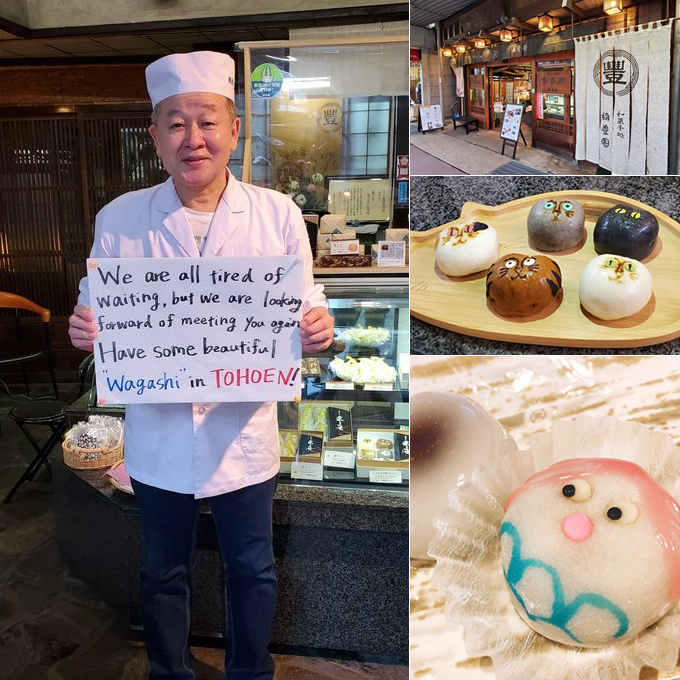Tohouen
𝟏 𝐒𝐞𝐥𝐟-𝐢𝐧𝐭𝐫𝐨𝐝𝐮𝐜𝐭𝐢𝐨𝐧
Tohouen was founded in 1901. I am the third-generation owner and pâtissier. We have been doing this business for 119 years. Since the start the shop has been selling different things, but now I'm focusing on Japanese sweets, “Wagashi”. We make both traditional and new things. We also completely manufacture our products here.
𝟐 𝐓𝐨𝐡𝐨𝐮𝐞𝐧'𝐬 𝐟𝐞𝐚𝐭𝐮𝐫𝐞𝐬
I think one of the major features is that our sweets are manufactured entirely by us. I think that to be able to select the materials is key to have a good “Wagashi”. Also, since Takayama is a tourist destination, I like to think that when travelers come to our shop they can enjoy the traditional sweets of Takayama.
𝟑 𝐌𝐞𝐦𝐨𝐫𝐢𝐞𝐬 𝐰𝐢𝐭𝐡 𝐜𝐮𝐬𝐭𝐨𝐦𝐞𝐫𝐬
This shop has a Japanese sweet called “Neko manju” which is a steamed yeast bun with the shape of a cat. It is very popular among both Japanese and foreign tourists.
There was one time when my daughter in low, who could speak English, served a guest from Singapore. They started talking, they got really close, to point that that my daughter in low showed her around Takayama and they even went to have a drink in the evening. This kind of thing makes me think that it is nice to have a job that lets me interact with different people around the world.
Once from France, we had a customer who wanted to see how Japanese sweets were made, and if possible, to experience it. It was sudden, but he was really passionate about it, so I decided to let him to come in and see the process. We even made sweets together.
𝟒 𝐃𝐢𝐟𝐟𝐞𝐫𝐞𝐧𝐜𝐞𝐬 𝐛𝐞𝐭𝐰𝐞𝐞𝐧 𝐖𝐞𝐬𝐭𝐞𝐫𝐧 𝐚𝐧𝐝 𝐉𝐚𝐩𝐚𝐧𝐞𝐬𝐞 𝐜𝐨𝐧𝐟𝐞𝐜𝐭𝐢𝐨𝐧𝐞𝐫𝐲
Nowadays, you can see Wagashi on SNS etc., but in the past, people often were skeptical about eating this kind of food. The ingredients of Western confectionery and Japanese confectionery are different, but one big difference is that when making Japanese confectionery, rice flour is used. Another big difference is that cakes or pice, for example, are stuffed and usually more attention is given to the outside rather than the inside. For the Japanese wagashi, attention is also given to the inside. The reason lies fact that Japanese sweets are usually ate for seasonal events or special occasions so, the inside must hint to that specific even.
𝟓 𝐃𝐢𝐟𝐟𝐢𝐜𝐮𝐥𝐭 𝐩𝐚𝐫𝐭 𝐨𝐟 𝐰𝐨𝐫𝐤
To master Japanese sweets takes a lot of times. Wagashi are made by hand, so body needs to get used to the process.
Also, I remember in the past, when I tried to make more modern sweets, I was criticized, but now we live in a more open world so I am receiving a lot of support from my customers.
𝟔 𝐑𝐞𝐜𝐨𝐦𝐦𝐞𝐧𝐝𝐞𝐝 𝐩𝐥𝐚𝐜𝐞𝐬 𝐢𝐧 𝐓𝐚𝐤𝐚𝐲𝐚𝐦𝐚
I grow up in Takayama, so I like going to Asahimachi and talking face-to-face while sharing a drink with my friends. I like the old town. Just living here, even if there are much less comforts comparing to a big city, is nice and relaxing. The atmosphere is great.
𝟕 𝐂𝐎𝐕𝐈𝐃-𝟏𝟗 𝐦𝐞𝐚𝐬𝐮𝐫𝐞𝐬
Staffs are wearing masks and is disinfectants spray is always ready on the corner. Also, we often open the shop’s door to change air.
When COVID-19 came out, I thought if I could do something to ease my customers hearts. It is something simple, but I had the idea to put a mask on the Nekomanju. I was not confident, but it became very popular and honestly it really helped me during the emergency. Following that, I also make Amabie manjuu. Amabie is a Japanese folklore beast that it is said to help people during the epidemies. This manju was very popular as well, especially online. I am really grateful for all the support and kinds messages my customers send to me.

